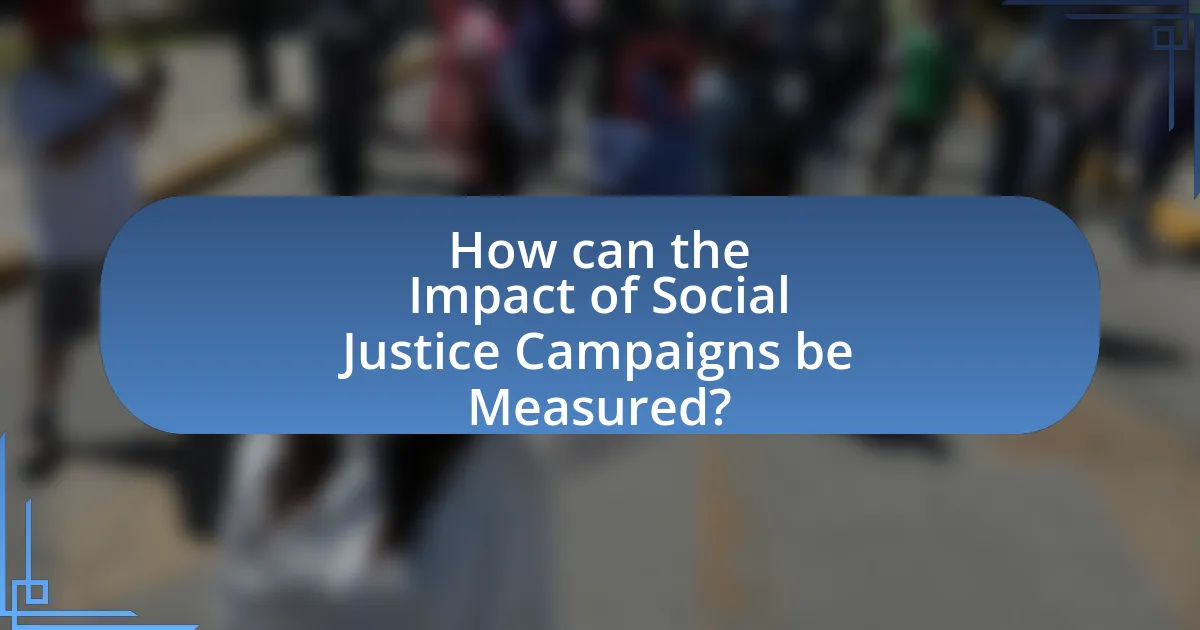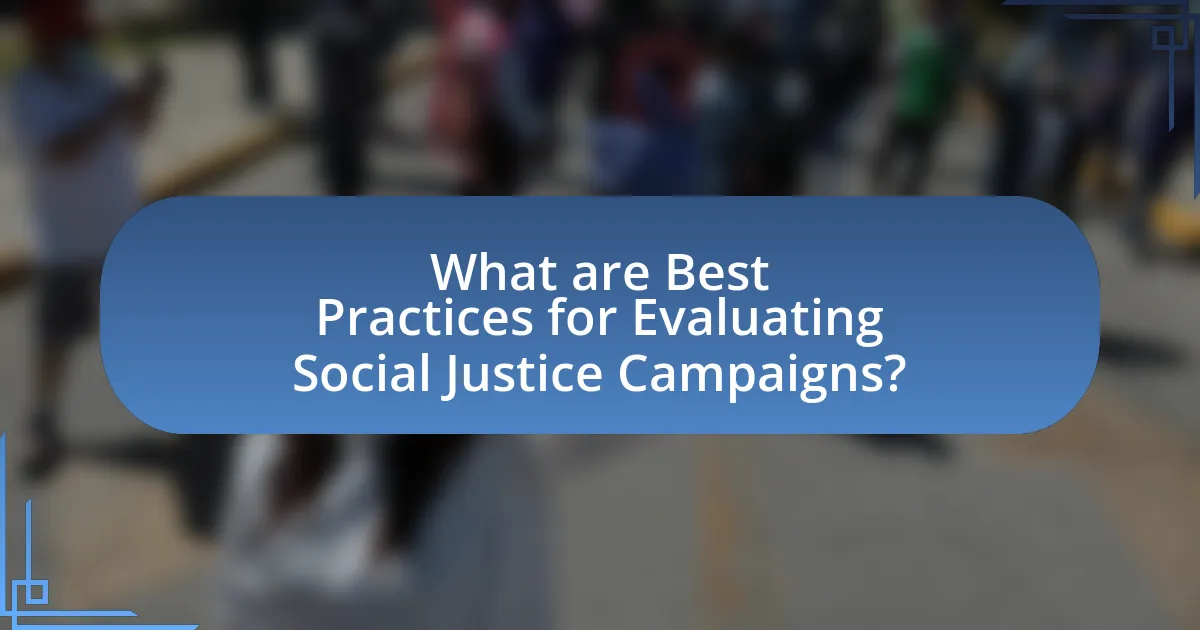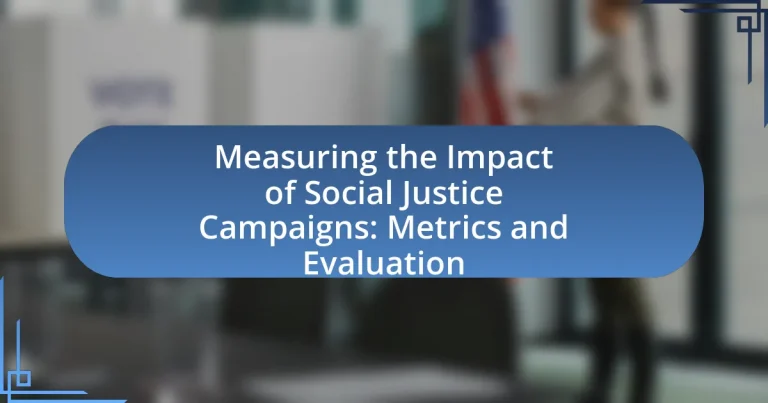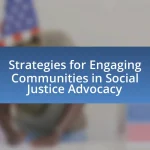Social justice campaigns are organized efforts aimed at promoting equality and advocating for the rights of marginalized groups, with significant impacts on public policy and societal awareness. This article explores the importance of these campaigns, their influence on society, and the key objectives they aim to achieve. It also addresses the challenges faced by social justice initiatives, the role of public engagement, and the significance of funding and resources in enhancing campaign effectiveness. Furthermore, the article outlines best practices for evaluating the impact of social justice campaigns, including the use of qualitative and quantitative metrics, and emphasizes the necessity of assessing outcomes to improve future strategies.

What are Social Justice Campaigns and Their Importance?
Social justice campaigns are organized efforts aimed at promoting equality, addressing systemic injustices, and advocating for the rights of marginalized groups. These campaigns are important because they raise awareness about social issues, mobilize communities for change, and influence public policy to create a more equitable society. For instance, the Black Lives Matter movement has significantly impacted discussions around racial inequality and police reform, demonstrating how social justice campaigns can lead to tangible policy changes and increased societal awareness.
How do Social Justice Campaigns influence society?
Social justice campaigns influence society by raising awareness of systemic inequalities and mobilizing collective action for change. These campaigns often lead to shifts in public opinion, policy reforms, and increased advocacy for marginalized groups. For instance, the Black Lives Matter movement has significantly impacted discussions around police reform and racial justice, resulting in legislative changes in various jurisdictions. Additionally, studies show that social media campaigns can amplify voices and foster community engagement, as seen in the #MeToo movement, which brought attention to sexual harassment and assault, leading to widespread societal dialogue and changes in workplace policies.
What are the key objectives of Social Justice Campaigns?
The key objectives of Social Justice Campaigns include promoting equality, advocating for marginalized communities, and raising awareness about social injustices. These campaigns aim to address systemic inequalities by influencing policy changes, fostering community engagement, and empowering individuals through education and advocacy. For instance, the Black Lives Matter movement has successfully highlighted racial disparities and pushed for reforms in policing practices, demonstrating the effectiveness of social justice campaigns in achieving tangible societal change.
Why is public engagement crucial for Social Justice Campaigns?
Public engagement is crucial for social justice campaigns because it fosters community involvement and amplifies diverse voices, leading to more effective advocacy. Engaging the public creates a sense of ownership and responsibility among community members, which can drive collective action and mobilize resources. Research indicates that campaigns with high levels of public engagement are more likely to achieve their goals; for instance, the 2018 March for Our Lives movement, which mobilized millions of participants, significantly influenced gun control legislation discussions in the United States. This demonstrates that public engagement not only raises awareness but also translates into tangible policy changes, reinforcing its importance in social justice efforts.
What challenges do Social Justice Campaigns face?
Social justice campaigns face significant challenges, including limited funding, public apathy, and resistance from established power structures. Limited funding restricts the ability to execute comprehensive outreach and advocacy efforts, as many campaigns rely on donations and grants that may not be consistently available. Public apathy can hinder engagement, as individuals may feel disconnected from the issues or overwhelmed by the scale of social injustices, leading to lower participation rates. Additionally, resistance from established power structures often manifests in political pushback, legal obstacles, or social backlash, making it difficult for campaigns to achieve their objectives. These challenges collectively impede the effectiveness and sustainability of social justice initiatives.
How do funding and resources impact campaign effectiveness?
Funding and resources significantly enhance campaign effectiveness by enabling comprehensive outreach, strategic planning, and impactful messaging. Campaigns with adequate funding can allocate resources toward targeted advertising, professional staffing, and data analytics, which are crucial for reaching and engaging the intended audience. For instance, a study by the Pew Research Center found that campaigns with higher budgets are more likely to utilize advanced digital marketing strategies, resulting in increased voter engagement and participation rates. Additionally, resources allow for the development of high-quality materials and the ability to respond swiftly to emerging issues, further solidifying a campaign’s presence and influence.
What role does public perception play in the success of these campaigns?
Public perception is crucial for the success of social justice campaigns as it directly influences public support, engagement, and funding. When the public views a campaign positively, it is more likely to gain traction, attract media attention, and mobilize community involvement. For instance, campaigns that resonate with societal values and address pressing issues often see increased participation and donations, as evidenced by the Black Lives Matter movement, which gained widespread support and visibility due to its alignment with growing public concern over racial injustice. This correlation between favorable public perception and campaign success underscores the importance of effectively communicating messages that resonate with the audience’s beliefs and values.

How can the Impact of Social Justice Campaigns be Measured?
The impact of social justice campaigns can be measured through a combination of quantitative and qualitative metrics. Quantitative metrics include changes in public opinion, voter turnout, and policy changes, which can be tracked through surveys, polls, and statistical analysis. For example, a study by the Pew Research Center found that social movements can significantly shift public attitudes on issues such as racial equality and LGBTQ+ rights, evidenced by increased support in surveys following major campaigns. Qualitative metrics involve assessing narratives and personal stories through interviews and focus groups, providing deeper insights into the campaign’s influence on individuals and communities. This dual approach allows for a comprehensive evaluation of both the measurable outcomes and the lived experiences shaped by social justice initiatives.
What metrics are commonly used to evaluate Social Justice Campaigns?
Common metrics used to evaluate social justice campaigns include engagement rates, demographic reach, policy changes, and community impact assessments. Engagement rates measure the level of participation and interaction from the target audience, indicating the campaign’s resonance. Demographic reach assesses how well the campaign reaches diverse populations, ensuring inclusivity. Policy changes reflect the campaign’s effectiveness in influencing legislation or organizational practices, serving as a direct measure of impact. Community impact assessments evaluate the tangible effects on the community, such as improvements in social conditions or increased awareness of social justice issues. These metrics provide a comprehensive framework for assessing the effectiveness and reach of social justice initiatives.
How do qualitative metrics differ from quantitative metrics?
Qualitative metrics differ from quantitative metrics in that qualitative metrics focus on descriptive, subjective data, while quantitative metrics emphasize numerical, objective data. Qualitative metrics capture insights through interviews, open-ended surveys, and observations, providing context and depth to social phenomena, such as personal experiences in social justice campaigns. In contrast, quantitative metrics utilize structured data collection methods like surveys with closed-ended questions, allowing for statistical analysis and generalization of findings, such as measuring the number of participants in a campaign or the percentage of individuals who support a cause. This distinction is crucial in evaluating social justice campaigns, as qualitative metrics can reveal underlying motivations and sentiments, while quantitative metrics can assess the scale and impact of initiatives.
What are the most effective tools for data collection in these campaigns?
The most effective tools for data collection in social justice campaigns include surveys, interviews, focus groups, and social media analytics. Surveys allow for quantitative data collection from a broad audience, while interviews and focus groups provide qualitative insights into personal experiences and perceptions. Social media analytics tools, such as Hootsuite and Sprout Social, enable campaigners to track engagement and sentiment in real-time, offering valuable data on public response. These tools are validated by their widespread use in various campaigns, demonstrating their effectiveness in gathering comprehensive data to measure impact and inform strategies.
Why is it important to assess the outcomes of Social Justice Campaigns?
Assessing the outcomes of Social Justice Campaigns is crucial for understanding their effectiveness and impact. This evaluation allows stakeholders to identify successful strategies and areas needing improvement, ensuring resources are allocated efficiently. For instance, a study by the Stanford Social Innovation Review found that campaigns with clear metrics for success are 50% more likely to achieve their goals. By measuring outcomes, organizations can adapt their approaches based on data-driven insights, ultimately enhancing their ability to foster social change.
How can evaluation lead to improved strategies in future campaigns?
Evaluation can lead to improved strategies in future campaigns by providing data-driven insights that identify strengths and weaknesses. By analyzing metrics such as engagement rates, conversion rates, and audience feedback, campaign managers can pinpoint what aspects were effective and which need adjustment. For instance, a study by the Stanford Social Innovation Review found that organizations that regularly evaluate their campaigns are 50% more likely to achieve their goals compared to those that do not. This evidence underscores the importance of systematic evaluation in refining strategies for greater impact in subsequent campaigns.
What are the potential consequences of failing to measure impact?
Failing to measure impact can lead to ineffective resource allocation. Without assessing the outcomes of social justice campaigns, organizations may continue funding initiatives that do not yield positive results, wasting time and money. For instance, a study by the Stanford Social Innovation Review highlights that organizations lacking impact measurement often struggle to demonstrate their value to stakeholders, which can result in decreased funding and support. Additionally, the absence of measurable outcomes can hinder the ability to learn from past efforts, preventing organizations from adapting strategies that could enhance effectiveness in future campaigns.

What are Best Practices for Evaluating Social Justice Campaigns?
Best practices for evaluating social justice campaigns include establishing clear objectives, utilizing both qualitative and quantitative metrics, and engaging stakeholders throughout the evaluation process. Clear objectives provide a framework for measuring success, while qualitative metrics, such as participant testimonials, and quantitative metrics, like demographic data and engagement statistics, offer a comprehensive view of impact. Engaging stakeholders, including community members and campaign participants, ensures that evaluations reflect diverse perspectives and experiences, enhancing the validity of findings. Research indicates that campaigns with well-defined goals and inclusive evaluation processes are more likely to achieve meaningful social change, as evidenced by studies showing that stakeholder involvement increases the relevance and applicability of evaluation outcomes.
How can organizations develop a robust evaluation framework?
Organizations can develop a robust evaluation framework by clearly defining their goals, selecting appropriate metrics, and implementing a systematic data collection process. This approach ensures that the evaluation framework aligns with the specific objectives of social justice campaigns, allowing for accurate measurement of impact. For instance, the use of both qualitative and quantitative metrics can provide a comprehensive view of campaign effectiveness. Research by the Stanford Social Innovation Review highlights that organizations that utilize mixed-method evaluations are better equipped to assess their social impact, as they can capture diverse perspectives and outcomes.
What steps should be taken to ensure stakeholder involvement in the evaluation process?
To ensure stakeholder involvement in the evaluation process, organizations should actively engage stakeholders from the outset by identifying them, communicating the evaluation’s purpose, and soliciting their input on evaluation design. Engaging stakeholders early fosters ownership and ensures that their perspectives and needs are integrated into the evaluation framework. Research indicates that stakeholder involvement enhances the relevance and utility of evaluation findings, as evidenced by a study published in the American Journal of Evaluation, which found that evaluations with stakeholder engagement are more likely to lead to actionable recommendations.
How can organizations balance qualitative and quantitative data in their evaluations?
Organizations can balance qualitative and quantitative data in their evaluations by integrating both types of data to provide a comprehensive understanding of their impact. This integration can be achieved through mixed-methods approaches, where quantitative data, such as survey results and statistical analyses, are complemented by qualitative insights from interviews and focus groups. For instance, a study by Creswell and Plano Clark (2017) emphasizes that combining these methods allows organizations to validate quantitative findings with qualitative narratives, enhancing the richness of the evaluation. By employing this strategy, organizations can capture the nuances of social justice campaigns, ensuring that both measurable outcomes and personal experiences are considered in their assessments.
What common pitfalls should be avoided in measuring campaign impact?
Common pitfalls to avoid in measuring campaign impact include relying solely on quantitative metrics, neglecting qualitative insights, and failing to establish clear objectives. Relying only on numbers can obscure the nuanced effects of a campaign, while qualitative data provides context and depth to the findings. Additionally, without clear objectives, it becomes challenging to assess whether the campaign met its goals, leading to misinterpretation of results. Research indicates that campaigns with defined metrics and a mix of qualitative and quantitative evaluations yield more accurate assessments of impact.
How can bias in data collection affect evaluation results?
Bias in data collection can significantly distort evaluation results by leading to inaccurate conclusions about the effectiveness of social justice campaigns. When data is collected in a biased manner, it may over-represent certain demographics or perspectives while under-representing others, skewing the overall findings. For instance, if a survey on community impact primarily includes responses from a specific socioeconomic group, the results may not accurately reflect the broader community’s experiences or needs. This misrepresentation can result in misguided policy decisions and ineffective resource allocation, ultimately undermining the goals of social justice initiatives. Studies have shown that biased data can lead to a 30% variance in evaluation outcomes, highlighting the critical importance of representative data collection methods.
What strategies can be implemented to ensure objectivity in evaluations?
To ensure objectivity in evaluations, implement standardized evaluation criteria that are consistently applied across all assessments. This approach minimizes bias by providing a clear framework for measurement, allowing evaluators to focus on specific, quantifiable outcomes rather than subjective interpretations. Research indicates that using rubrics can enhance reliability in evaluations, as they delineate expectations and reduce variability in scoring (Brookhart, 2013). Additionally, incorporating multiple evaluators can further enhance objectivity, as diverse perspectives can balance individual biases, leading to a more comprehensive assessment.
What practical tips can enhance the evaluation of Social Justice Campaigns?
To enhance the evaluation of Social Justice Campaigns, implement clear, measurable objectives from the outset. Establishing specific goals allows for targeted assessment of outcomes, such as increased community engagement or policy changes. Additionally, utilize both qualitative and quantitative data collection methods, including surveys and interviews, to capture a comprehensive view of the campaign’s impact. For instance, a study by the Stanford Social Innovation Review highlights that campaigns employing mixed-methods evaluations can better illustrate the nuances of social change. Regularly review and adjust evaluation metrics based on feedback and changing contexts to ensure relevance and effectiveness.


